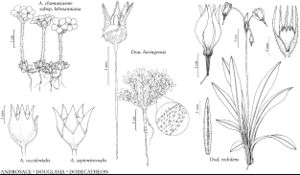Androsace occidentalis
Fl. Amer. Sept. 1: 137. 1813 ,.
Plants annual, inconspicuous, not mat-forming. Leaves in single rosette; petiole obscure; blade lanceolate, oblanceolate, or spatulate, 5–30 × 4–9 mm, base obscurely narrowing to stem, margins with simple hairs, surfaces puberulent, hairs simple. Scapes 1–15, 2–10 cm, glabrescent to puberulent. Inflorescences 3–15-flowered; involucral bracts lanceolate to elliptic or ovate, relatively broad. Pedicels erect to arcuate, slender, unequal, 0.3–3 cm. Flowers: calyx broadly campanulate, ridged, 3–5 mm, lobes erect, broadly lanceolate, apex acute to obtuse; corolla tube equaling or shorter than calyx, limb ca. 3 mm diam. Capsules ± equaling calyx, 3–5 mm. 2n = 20.
Phenology: Flowering early-mid summer.
Habitat: Open, grassy meadows, sandy or gravelly open soils, often in disturbed areas
Elevation: 300-1700 m
Distribution

Alta., B.C., Man., Ont., Sask., Ariz., Ark., Calif., Colo., Idaho, Ill., Ind., Iowa, Kans., La., Mass., Mich., Minn., Mo., Mont., Nebr., N.Mex., N.Dak., Ohio, Okla., S.Dak., Tex., Utah, Wis., Wyo.
Discussion
Androsace occidentalis is widespread across the central and western United States, extending into southern Canada. It is often confused with A. septentrionalis, with which it overlaps geographically somewhat in the western portion of its range. Androsace occidentalis is generally restricted to lower elevations and is distinguished by its broad involucral bracts and cup-shaped calyx. In A. septentrionalis, the involucral bracts are narrow and the calyx V-shaped at the base, a shape enhanced by the more prominent calyx ridges. Hybridization between A. occidentalis and A. septentrionalis has not been documented; some specimens from intermediate elevations in the Four Corners area show intermediate bract morphology and slight glandular pubescence, a characteristic of some southwestern populations of A. septentrionalis.
Selected References
None.
